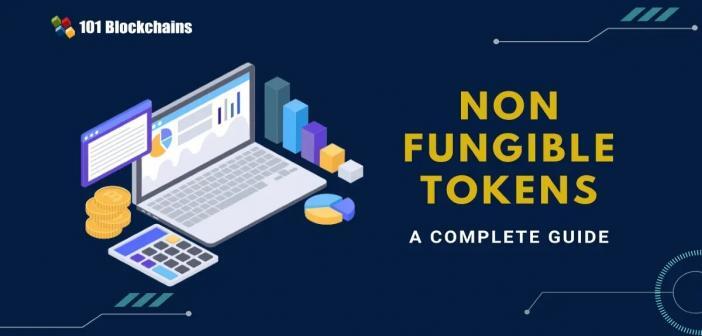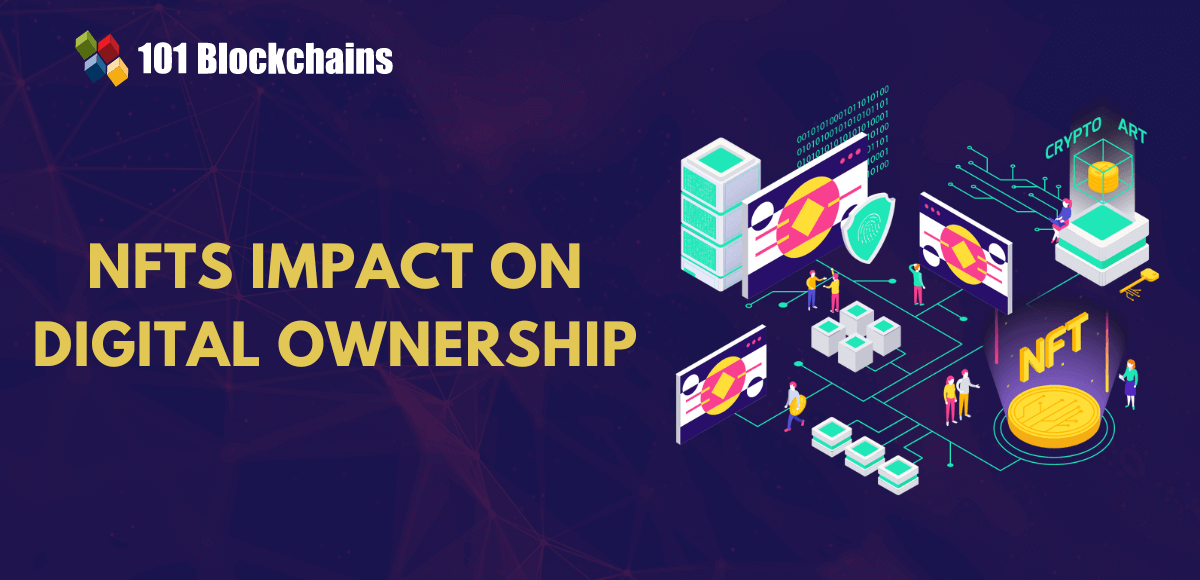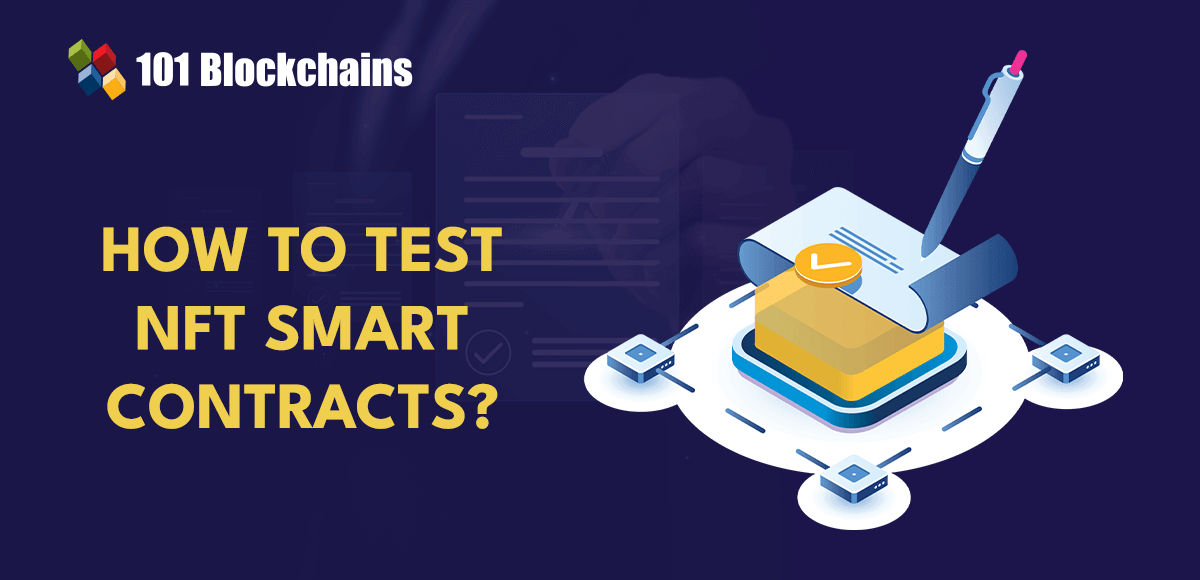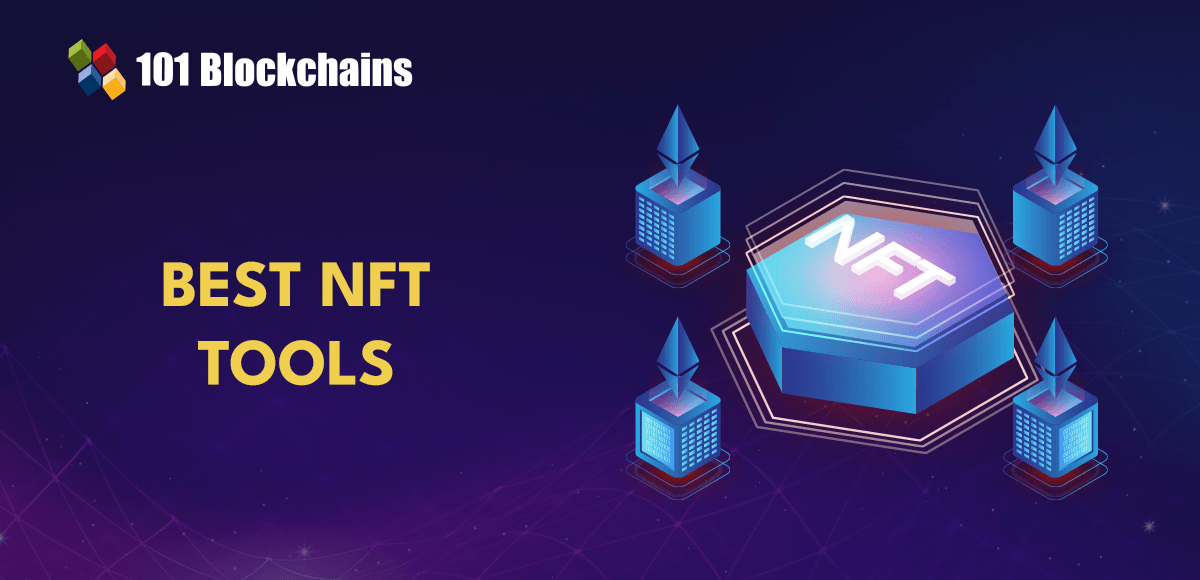Learn how blockchain truly works, master key definitions, and uncover what makes smart contracts so "smart." Dive into the fundamentals, gain valuable insights, and start your blockchain journey today!

- NFT
101 Blockchains
- on September 02, 2021
Non Fungible Tokens (NFTs): A Complete Guide
This article takes a deeper dive into the fundamentals of Non Fungible Tokens (NFTs) — including the definition, examples, and applications.
We have talked about blockchain, we have talked about tokens, and we have talked about the differences between tokens and coins, which means now is the time to discuss a little advanced and latest form of tokens — Non Fungible Token — also known as NFT. There is also a valid reason why we all need to have a good understanding of Non Fungible Tokens. According to some experts, NFTs can shape the future of blockchain, which is why they are getting tractions from enthusiasts and users.
Non Fungible Tokens: A Little Background
The term fungible means something that can be replaced by something similar. So, by the name Non Fungible Tokens, we can easily understand that we are talking about a type of token that can’t be replaced by another similar token. It is unique and non-interchangeable. But, is this enough to understand the concept behind Non Fungible Tokens? No, so let’s dig a little deeper.
In the context of blockchain and cryptocurrency, the tokens are a key concept. Tokens are also available in different forms and are used for a variety of reasons. NFT is one of the types of tokens with its unique features and applications. You can also read our detailed guide on different types of security tokens here.
In the context of cryptocurrency, fungibility is important. In fact, for any currency, traditional or digital, fungibility is desired as most currencies aim to be a medium of exchange. For example, you can exchange a US-dollar with any other US-dollars. Not only that, but you can also exchange it with British Pound, or Pakistani Rupee. This is fungibility.
If you lend a dollar to someone, you don’t need the exact same dollar with the same serial number, right? This is fungibility. However, if you lend someone a limited-edition baseball card, you need the same exact limited edition baseball card, this is non-fungibility. Fungibility is also a key feature of all major cryptocurrencies like Bitcoin and Ethereum.
However, NFT emerged as a new type of token with its unique set of features. It also has some very interesting applications. As the concept is new, many people don’t understand it, the associated features, its future, and what it can be used for. In this article, we will look into the definitions, features, and applications in detail, so keep reading.
Want to get an in-depth understanding of non-fungible tokens (NFTs)? Enroll now in the NFT Fundamentals Course.
What are Non Fungible Tokens?
NFT is a type of token that is not interchangeable and is distinguishable from each other. This characteristic makes it differentiated and desirable in some cases. As mentioned above, a real-life example can be a limited-edition baseball card. Another example is a plane ticket, as you cannot exchange your ticket with someone else’s. It is a virtual token that you create to verifiably prove authenticity and ownership of an asset, through cryptography.
For example, if you have a virtual property, like a virtual piece of art, you can create a Non Fungible Token to tokenize the artwork. The NFT you now own reflects that the ownership of the artwork belongs to you. It is non-interchangeable as your artwork is unique. The NFT is stored on the blockchain as your property.
Non Fungible Token is the best example of how a token can be used to create scarcity, which results in the creation of value for that token. The best case is CryptoKitties, which I will discuss in detail in the next few paragraphs. A digital kitty was sold for up to USD 120,000 on CryptoKitties, by following this principle.
You can also define Non Fungible Tokens as — “a type of token that creates digital scarcity, and can be verified without any centralized organization that authenticates it.” For this, NFTs use blockchain, which allows these tokens to use a decentralized way to keep digitally scarce items.
Learn the concept, elements, future and use cases of NFTs from Non Fungible Tokens (NFTS) E-Book
NFTs Providing New Opportunity to Investors
In the last few months, NFTs are heavily used for this purpose. Many people are creating digital art or different digital stuff, often nothing more than useless crap, and tokenizing it using NFTs to create value.
However, there is a more productive use of NFTs that is getting popular and expected to go mainstream in the near future. This is the tokenization of physical assets as well as worthy virtual assets, like actual artwork, memorabilia, and turning them into tokenized securities. This creates a new opportunity for investment. In simple words, by tokenizing tangible assets, investors can have more liquidity.
Also, keep in mind, NFT is a recent phenomenon, but with a lot of applications. Most people are still in the process of understanding it and finding ways to implement it and use it.
Who Created NFT?
The first Non Fungible Token was created by Witek Radomski, the co-founder of Enjin Coin when he wrote the code for the first coin back in June 2017. However, the code was released to the public two months later in August.
Excited to develop an in-depth understanding of solidity’s best practices and the tools needed for developing and testing an NFT marketplace, Enroll now in the NFT Development Course
Non Fungible Tokens Use Cases
Non Fungible Tokens are used in a variety of ways today, and you can find several examples of NFT like –
-
Gaming
One of the first uses, in fact, the game that introduced the concept of NFTs to the world was the game CryptoKitties that was based on the blockchain. In the game that is based on the Ethereum blockchain and ERC-721 standard, you collect, buy, breed, and sell digital kitties, each digital kitty with its own genetic characteristics and features stored on the blockchain.
There’s a difference between ERC-721 and ERC-20 token, which is the standard protocol in the Ethereum network. While the ERC-20 represents a single type of asset, ERC-721 denotes an entire class of assets. This initiated the idea of Non Fungible Tokens. The game become so popular that the sales crossed over USD 12 million within a year.
Another popular example is Decentraland, which is a game about digitally scarce land. You can purchase, develop, and sell the land in Decentraland using Non Fungible Tokens. You have full control over your land, you can build anything over it, make it unique, and can add value to it. The game uses the 360-degree virtual world, so you feel like you are in the real world.
The ownership of in-game assets in the above games using Non Fungible Tokens has created value for these assets. You can sell your in-game assets in both games, for a profit, by selling your Non Fungible Tokens.
Several other games came into existence with the same concept, making use of NFT. Non Fungible Tokens opened a gate of possibilities for the gaming industry, which is already booming when it comes to annual revenue and growth. Using NFT, people now can own, buy, and sell their game characters.
-
Collectibles
One of the most common examples of NFTs is the use of these tokens to keep digital assets to your name. We have already discussed the example of digital art above. You can create an NFT for any digital asset to make it unique and your virtual asset. In simple words, NFT offers indisputable ownership of in-game assets as well as virtual goods. There is a possibility that in near future, it will also be used for the ownership of tangible items, like homeownership. In fact, according to a recently published article on Forbes, Non Fungible Tokens from physical collectibles are playing a role to strengthen asset-backed securities.
-
Licensing
Another great example of an effective use of NFT is to use it for software licensing. According to experts, creating NFT based licenses can reduce piracy, and allows people to sell their license in an open market for even profit. This way, users can also avoid yearly subscriptions, use a software against the purchased license, and after the use, sell it to someone else. The license, in this case, acts as an asset for users.
Software developers can also benefit as they can create smart contracts that will allow profit share on resale or anything else that can also generate revenue for the original developer. It is a win-win situation NFT offers to both users and developers. It can reduce piracy and can also allow the users to earn some money on their purchase.
Start learning Non-Fungible Token with World’s first NFT Skill Path with quality resources tailored by industry experts Now!
Non Fungible Token Examples and Standards
In case of fungible tokens, the most common standard is ERC-20 which is based on Ethereum. However, Non Fungible Tokens use a different set of standards and protocols, like ERC-721 which is based on Ethereum, or its latest upgrade ERC-1155, or a different standard based on the NEO blockchain platform.
-
ERC-721 Non Fungible Tokens
At this time, most NFTs are implemented on top of the Ethereum platform as ERC-721 tokens. You can find other Non Fungible Token examples with different standards and on other protocols and blockchain, like the ones on NEO blockchain or EOS blockchain, but ERC-721 is currently the most popular NFT standard. It also sits among the best Non Fungible Tokens.
ERC-721 features a set of standard functions and attributes that define it, in the form of a smart contract. You need to follow these attributes and functions to own, trade, and manage ERC-721. Simply put, ERC-721 provides us with a standard to create and exchange Non Fungible Tokens. Each ERC-721 token is unique, which is not the case with ERC-20 tokens.
There is another key difference between ERC-721 and ERC-20 tokens. ERC-20 tokens are divisible, just like you can divide $10 into two $5 bills. However, ERC-721 tokens are non-divisible. Can anyone in his right mind split the ticket or a baseball card? No, the same is the case with Non Fungible Tokens. ERC-721 is currently the most used standard for blockchain digital art and gaming. It has been used by hundreds of Dapps so far, and over a million one-of-a-kind tokens have been created.
Curious about the Ethereum Technology ? Enroll now in Ethereum Technology Course
-
ERC-721 vs. ERC-1155
Even though ERC-721 was an instant success, used to create probably millions of NFTs, but it also had some limitations. For example, it was expensive, and according to the creator of Non Fungible Token, Redomski, also inefficient to deploy large databases of items. To overcome these shortcomings, Witek Radomski decided to create his own standard, the ERC-1155. This means ERC-1155 is an advanced and better version of ERC-721 that offers a lot of new possibilities to create NFTS.
For example, with the new ERC-1155 standard, you can now use infinite numbers of Non Fungible as well as Fungible items in a single deployed smart contract. According to Witek Radomski, it is also easy for the blockchain network to handle. He also claims that this new set of standards is not only good for the blockchain-based gaming industry but also a good option to create tokens for all forms of ownership, no matter digital or tangible.
-
How ERC-1155 Can be a Better Alternative to ERC-721 and ERC-20?
ERC-1155 was developed in response to the limitations of ERC-721 and ERC-20, which makes it a better alternative. For example, the common problem with both ERC-721 and ERC-20 is the limitation of deployment of separate smart contract for every individual token type. This gives birth to an infinite amount of repeated data in both ERC-20 and ERC-721 tokens.
What does this mean?
A repeated code on millions of tokens on machines all over the world, resulting in a waste of processing power, electricity, and storage space. The ERC-1155 standard is the solution to the above problem. In the new standard, you can store the bulk of the code in a central contract for each token variation, which is given an identification number.
Next, each new token that requires the same code can use it through an assigned ID. With that assigned ID, you can use the coding without any need to copy and paste the same data. ERC-1155 also allows you to perform more than one complex task in a single transaction. This will reduce congestion on the Ethereum blockchain. For example, in the ERC-1155 standard, operations like approval, transfer, trading, and melting take arrays as parameters. This allows you to perform around 100 to 200 functions in a single transaction.
ERC-1155 also allows you to create both Fungible and Non Fungible Tokens, something that was not possible with ERC-20 (Fungible tokens only) and ERC-721 (Non Fungible Tokens only).
Want to learn the basic and advanced concepts of Ethereum? Enroll in our Ethereum Development Fundamentals Course right away!
-
ERC721 vs ERC1155: Comparison Table
| ERC-721 | ERC-1155 | |
|---|---|---|
| Token Creation | Only one token in a single contract | Multiple tokens in a single contract |
| Limitation | Can only create NFTs | Can create both Fungible and Non Fungible Contracts |
| Cost | Expensive | Cheaper |
| Ease of Use | Allows single operation for each transaction | Allows multiple operations in a single transaction |
| Storage Requirement | More | Less |
| Efficiency | Low | High |
Non Fungible Tokens List
-
Non Fungible Token on Stellar
Stellar is another popular decentralized blockchain-based protocol that allows users to send money to any part of the world. The platform is among the most affordable ways to send money to anyone, in any currency, and instantly. They have recently started using NFTs as well. It uses Stellar accounts to represent each individual unique Non Fungible Token.
Each token uses the unique metadata that distinguishes it from the other token, and digitally signed by the account creator before it is stored on IPFS object. In return, the IPFS multi-hash is used as a secret key for the account/user associated with the token. However, keep in mind, unlike other common forms of NFTs, Non Fungible Tokens on Stellar are not tradable on the Stellar DEX.
Get familiar with the basic and advanced Non-Fungible Token (NFT) terms with the NFT Flashcards
-
Non Fungible Token for EOS
We have already mentioned the NFT standards used on Ethereum, the ERC-721 and ERC-1155. There is also a standard used on NEO. However, is there a Non Fungible Token for EOS? Yes, there is. A few months back, UNICO and EOS Cafe Calgary partnered up to create the Non Fungible Token Standard for EOS. This allows developers to create NFTs on EOS as well, other than Ethereum and NEO blockchain.
-
Non Fungible Token for NEO
There are several teams working on developing and improving Non Fungible Token standards on NEO blockchain, a leading Chinese smart contract platform
In a recent interview, the CEO of NEO, Da Hongfei showed his interest in Non Fungibility of tokens. He also claimed that they are working on a similar standard as ERC-721 on the Ethereum blockchain for NEO as well.
This is what Hongfei said in one of his interviews back in July 2018 — “We have had a standard just get approved. It will be merged into our main branch. Non-fungible tokens are also a strategy for NEO. When gaming hits blockchain, you get collectables. Those collectables can be traded on blockchain so it’s a perfect match.”
In March 2018, the founder of Trinity Protocol, David Li also proposed his NEP-10 standard for Non Fungible Tokens on NEO platform. This new standard is different from the NEP5 standard, which is used for creating fungible tokens on NEO.
The Future of Non Fungible Token
As the more practical uses of blockchain technology emerge and blockchain getting main-stream, you can expect more people tokenizing their digital as well as tangible assets on the blockchain. For this, they need NFTs. We have already discussed its possible applications in the gaming industry, licensing of software, and keeping collectibles. Similarly, NFTs can be used to certify identification and even property ownership.
Another possibility is its use in the financial industry to tokenize traditional assets like precious metals, stocks, or bonds. It depends on the future migration of these high-value assets to the blockchain in the future. NFTs can also become immutable and secure way of keeping academic credentials, birth certificates, identities, and warranties.
Learn more about the basics of NFT (Non-Fungible Token) and the practical implications of non-fungible tokens through NFTs Skill Path
Final Words
Non Fungible Tokens are no doubt a new kid on the block that you need to keep your eyes on. The applications of this new type of token are still under progress, but it is already getting popular mostly because of its use in games, specifically for monetizing in-game assets like CryptoKitties. Make sure you start to check out this type of blockchain as well. For more details, you can start with our blockchain courses to get started!
*Disclaimer: The article should not be taken as, and is not intended to provide any investment advice. Claims made in this article do not constitute investment advice and should not be taken as such. 101 Blockchains shall not be responsible for any loss sustained by any person who relies on this article. Do your own research!






